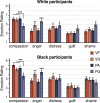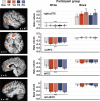Effects of early adversity and social discrimination on empathy for complex mental states: An fMRI investigation
- PMID: 31506497
- PMCID: PMC6737126
- DOI: 10.1038/s41598-019-49298-4
Effects of early adversity and social discrimination on empathy for complex mental states: An fMRI investigation
Abstract
There is extensive evidence of an association between early adversity and enduring neural changes that impact socioemotional processing throughout life. Yet little is known about the effects of on-going social discrimination on socioemotional functioning. Here we examined how cumulative experiences of social discrimination impact brain response during empathic responding-a crucial issue in South Africa, given its historical apartheid context and continuing legacies. White and Black South Africans completed measures of social adversity (early adversity and social discrimination), and underwent fMRI while viewing video clips depicting victims and perpetrators of apartheid crimes. Increased neural response was detected in brain regions associated with cognitive rather than affective empathy, and greater social adversity was associated with reduced reported compassion across participants. Notably, social discrimination (due to income level, weight, gender) in White participants was associated with increased amygdala reactivity, whereas social discrimination (due to race) in Black participants mediated the negative associations of temporoparietal junction and inferior frontal gyrus activation with compassion during emotionally provocative conditions. These findings suggest that (i) social discrimination has comparable associations at the neural level as other psychosocial stressors, and that (ii) the mechanisms underlying empathic responding vary as a function of the type of social discrimination experienced.
Conflict of interest statement
The authors declare no competing interests.
Figures





Similar articles
-
Empathy and moral emotions in post-apartheid South Africa: an fMRI investigation.Soc Cogn Affect Neurosci. 2017 Jun 1;12(6):881-892. doi: 10.1093/scan/nsx019. Soc Cogn Affect Neurosci. 2017. PMID: 28338783 Free PMC article.
-
Effects of empathic social responses on the emotions of the recipient.Brain Cogn. 2016 Mar;103:50-61. doi: 10.1016/j.bandc.2015.11.004. Epub 2016 Feb 4. Brain Cogn. 2016. PMID: 26812250
-
Tracking emotions in the brain - Revisiting the Empathic Accuracy Task.Neuroimage. 2018 Sep;178:677-686. doi: 10.1016/j.neuroimage.2018.05.080. Epub 2018 Jun 8. Neuroimage. 2018. PMID: 29890323 Free PMC article.
-
Meta-analytic evidence for common and distinct neural networks associated with directly experienced pain and empathy for pain.Neuroimage. 2011 Feb 1;54(3):2492-502. doi: 10.1016/j.neuroimage.2010.10.014. Epub 2010 Oct 12. Neuroimage. 2011. PMID: 20946964 Review.
-
The neural bases for empathy.Neuroscientist. 2011 Feb;17(1):18-24. doi: 10.1177/1073858410379268. Epub 2010 Nov 11. Neuroscientist. 2011. PMID: 21071616 Review.
Cited by
-
COVID-19 as Natural Intervention: Guilt and Perceived Historical Privilege Contributes to Structural Reform Under Conditions of Crisis.Affect Sci. 2022;3(1):34-45. doi: 10.1007/s42761-021-00073-7. Epub 2021 Sep 30. Affect Sci. 2022. PMID: 34608456 Free PMC article.
-
Exploring the Role of Empathy in the Association Between Early Life Adversity and Antisocial Behavior.Affect Sci. 2024 Oct 2;6(1):128-144. doi: 10.1007/s42761-024-00280-y. eCollection 2025 Mar. Affect Sci. 2024. PMID: 40094041
-
Childhood abuse and neglect are differentially related to perceived discrimination and structural change in empathy-related circuitry.Sci Rep. 2025 May 10;15(1):16361. doi: 10.1038/s41598-025-00679-y. Sci Rep. 2025. PMID: 40348824 Free PMC article.
-
A systematic review of the neural correlates of sexual minority stress: towards an intersectional minority mosaic framework with implications for a future research agenda.Eur J Psychotraumatol. 2022 Feb 28;13(1):2002572. doi: 10.1080/20008198.2021.2002572. eCollection 2022. Eur J Psychotraumatol. 2022. PMID: 35251527 Free PMC article.
-
Early Life Adversity and Empathy: A Scoping Review of Past Research and Recommendations for Future Directions.Clin Child Fam Psychol Rev. 2025 Jun;28(2):275-321. doi: 10.1007/s10567-025-00516-8. Epub 2025 Mar 24. Clin Child Fam Psychol Rev. 2025. PMID: 40126772
References
Publication types
MeSH terms
LinkOut - more resources
Full Text Sources
Medical
Molecular Biology Databases

